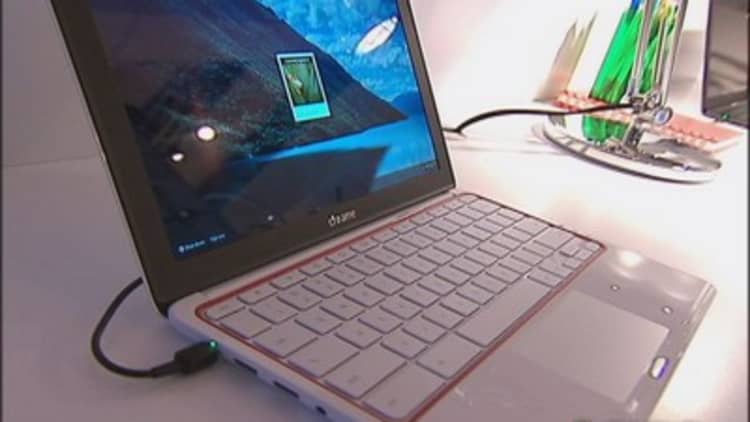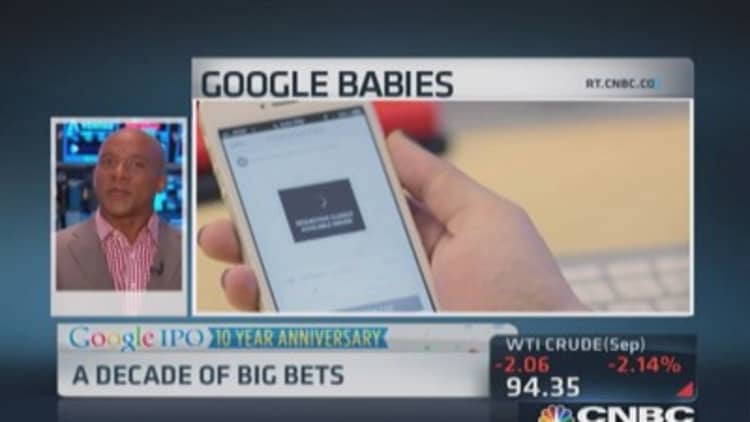In her first year as principal of the all-girls Fontbonne Hall Academy, Mary Ann Spicijaric was leading a grand experiment that couldn't be discussed outside the halls of her Catholic high school in Brooklyn. The 38 teachers, along with school administrators and attendees, were under strict rules to keep quiet about the new Web-based software they were testing that helped educators manage assignments, grade papers and communicate with students.
As Spicijaric enters her second school year at Fontbonne, the secret is out and it has a name: Google Classroom.
Google, the world's largest Internet company by market value, is in the early days of its next big bet. The company is providing any school, from kindergarten through college, with a hub for online learning and classroom management that wraps in Google's suite of Web products, including Gmail, documents and spreadsheets, presentation tools and cloud storage. No more carrying around stacks of research papers, returning exams during valuable class time or "my dog ate my homework" excuses. Kids at Fontbonne are now instructed to bring their own devices—laptops, tablets or smartphones—because the school is going paperless
"I'm seeing teachers excited about teaching again," said Spicijaric, a 25-year educator, who previously led the science department of a Catholic school in Queens. "When you can focus on instruction as opposed to all the classroom management stuff that teachers have to worry about, it makes the job more fun."
Read MoreGoogle's massive footprint
And get this – it's all free. Google, which generates $16 billion in quarterly revenue and has over $60 billion in cash, thanks to its ubiquitous search engine and advertising machine, is doing everything possible to get its products in users' hands, even if means giving stuff away. In education, where budgets are notoriously tight and resources scarce, free is the only reliable business model.
For Mountain View, California-based Google, the free software is part of a broader strategy. Android is a free open source platform that any phone or tablet manufacturer can use to power the smartphones and tablets they sell. Chromium OS is also available for anyone, and is the software behind Google's Chrome operating system and Chromebook laptops, which sell for as little as $200.
By getting kids fluent in Google tools at an early age, the thinking goes, Google will be well positioned when those students grow into highly monetizable consumers.
Still, there's no guarantee Google will be the winner.
Microsoft has been trying to crack the education market with its cloud-based Office 365 software and student discounts on Surface devices. Apple has an "iPad in Education" initiative with a variety of classroom apps tied to its products. And venture-backed start-up Edmodo has over 40 million teachers, students and parents using its educational social network. Brett Kopf, co-founder and chief executive officer of Remind, a messaging app for teachers to securely communicate with students and their parents, calls it an "inflection point" for education because of the proliferation of mobile technology.
HP's Chromebook

But of all the efforts made by tech companies to digitize the classroom, Google has built the biggest game-changer, said Ryan Carson, co-founder and CEO of Treehouse, a site that provides online classes for building websites and apps. While Google hasn't opened Classroom to third-party developers, Carson said it's the platform that has the best shot of creating an education app store on top of its own services, similar to the Play store on Android. More than 1 million Chromebooks were sold to schools in the second quarter of this year, according to Google, and Carson said he's seeing "school after school rely on it."
"They're going to be almost unstoppable, because they're willing to throw away so much money on Chrome OS and Chromebooks," said Carson, whose Portland, Oregon-based start-up currently serves over 86,000 students and companies. Though Carson has no knowledge of Google's strategy beyond what it's announced publicly, he sees the push as getting students signed on with Google credentials at the earliest possible age. "If that becomes central to your learning experience, they've got you."
Google is quick to point out that its approach is device agnostic. Classroom is designed to work just as well on iPads, Windows-powered gadgets and in any browser as it is on Chrome, said Zach Yeskel, product manager for Classroom, and a former high school math teacher. And within Classroom, teachers aren't restricted to just using Google's software. They can import files from programs like Microsoft Word and Excel as well as Adobe Acrobat.
"We tried to make it as generally applicable as possible," said Yeskel, who is based in Google's New York office along with the Classroom team. It was created to "work as well in kindergarten as in a special seminar in a college class."
Google says that seven of the eight Ivy League colleges use its education software, called Google Apps for Education, introduced about seven years ago to let schools utilize its small business programs for free while also blocking advertisers. Across all levels of education, that product now has more than 30 million users. Student accounts are provided by information technology departments at the district or school level, where devices are also registered and secured.
Read MoreReal cost of an Ivy League education
Last year, Google piloted Classroom, the newest part of the education suite, with about 100 teachers, including those at Fontbonne, to get early feedback from educators and students. Since inviting a wider swath of teachers into a product preview in May, over 100,000 educators from more than 45 countries have signed up. Classroom takes the education tools Google already had and adds the ability to create and collect assignments, communicate directly with students and let them see what's due and when.
Heidi Bernasconi, a high school biology teacher, has been using Google's education apps for seven years and was part of last year's pilot for Classroom. Prior to the start of classes last week, Bernasconi trained 103 teachers at Clarkstown High School North in New City, New York, as the school prepares for a wider rollout.
Like Google, which has a well-known practice of encouraging employees to spend 20 percent of their time on independent projects, Bernasconi has her own version of 20 percent time. In her Marine Biology class for seniors, she had students last year spend the equivalent of one day a week on a project tied to their desired career as long as it was related to the ocean.
Google: More than just search

Students used a variety of multimedia tools like YouTube videos, music files and photos. One student created a fashion line based on coral reefs and another wrote a children's book. Google Classroom was at the heart of it, letting students get feedback from one another, share files with colleagues and solicit comments from Bernasconi, when her guidance was needed.
"The kids and I go back and forth with drafts and different pieces and components of projects," Bernasconi said. "It makes the workflow of long-term assignments really efficient."
As with all things Google, particularly when kids are involved, privacy is an issue. The company faces constant scrutiny for how much it knows about users, what it sells to advertisers, and what's available to the government (read: National Security Agency). Within the education sphere, Google took a big step in April, when it turned off all advertising, disabling a feature that formerly let program administrators opt in to some ads. So whether in search, Gmail, or any of its apps, if users are signed into their education account, no ads are present and Google isn't collecting information for advertising.
Read MorePresident Obama outlines NSA reforms
"Protecting the privacy and security of all users, including students, is our top priority," Yeskel said.
Before last year's pilot, only one parent at Spicjaric's 500-student school expressed concern about privacy. That was a relief to Spicjaric, because as a long-time educator, the opportunity to implement free and simple-to-use software is not something that's often crossed her desk.
"It's easily accessible and very cost effective," she said. "That has the tendency of being one of the major stumbling blocks in terms of education and getting technology into schools."
—By CNBC's Ari Levy.





